Fabrication of Effective Co-SnO2/SGCN Photocatalysts for the Removal of Organic Pollutants and Pathogen Inactivation
Abstract
1. Introduction
2. Experimental
2.1. Materials
2.2. Synthesis of SnO2 Nanoparticles
2.3. Synthesis of Co-SnO2
2.4. Synthesis of Sulfur Doped Graphitic Carbon Nitride
2.5. Synthesis of Co-SnO2/SGCN Nanocomposites
2.6. Material Characterization
2.7. Photocatalytic Activity
2.8. Antibacterial Activity
2.8.1. Preparation of Inoculum
2.8.2. Preparation of Petri Plates
3. Results and Discussion
3.1. XRD Analysis
3.2. Morphology and Elemental Composition Analysis
3.3. FTIR Analysis
3.4. Optical Properties
3.5. Photocatalytic Study
3.6. Photocatalytic Degradation Mechanism
4. Conclusions
Author Contributions
Funding
Data Availability Statement
Acknowledgments
Conflicts of Interest
References
- Qamar, M.A.; Shahid, S.; Javed, M.; Shariq, M.; Fadhali, M.M.; Madkhali, O.; Ali, S.K.; Syed, I.S.; Awaji, M.Y.; Shakir Khan, M.; et al. Accelerated Decoloration of Organic Dyes from Wastewater Using Ternary Metal/g-C3N4/ZnO Nanocomposites: An Investigation of Impact of g-C3N4 Concentration and Ni and Mn Doping. Catalysts 2022, 12, 1388. [Google Scholar] [CrossRef]
- Rasalingam, S.; Wu, C.-M.; Koodali, R.T. Modulation of Pore Sizes of Titanium Dioxide Photocatalysts by a Facile Template Free Hydrothermal Synthesis Method: Implications for Photocatalytic Degradation of Rhodamine B. ACS Appl. Mater. Interfaces 2015, 7, 4368–4380. [Google Scholar] [CrossRef] [PubMed]
- Di Mauro, A.; Cantarella, M.; Nicotra, G.; Pellegrino, G.; Gulino, A.; Brundo, M.V.; Privitera, V.; Impellizzeri, G. Novel synthesis of ZnO/PMMA nanocomposites for photocatalytic applications. Sci. Rep. 2017, 7, 40895. [Google Scholar] [CrossRef] [PubMed]
- Mulushewa, Z.; Dinbore, W.T.; Ayele, Y. Removal of methylene blue from textile waste water using kaolin and zeolite-x synthesized from Ethiopian kaolin. Environ. Anal. Health Toxicol. 2021, 36, e2021007. [Google Scholar] [CrossRef] [PubMed]
- Uddin, M.J.; Ampiaw, R.E.; Lee, W.J.C. Adsorptive removal of dyes from wastewater using a metal-organic framework: A review. Chemosphere 2021, 284, 131314. [Google Scholar] [CrossRef] [PubMed]
- Elango, G.; Roopan, S.M.; Biology, P.B. Efficacy of SnO2 nanoparticles toward photocatalytic degradation of methylene blue dye. J. Photochem. Photobiol. B Biol. 2016, 155, 34–38. [Google Scholar] [CrossRef] [PubMed]
- Qamar, M.A.; Javed, M.; Shahid, S.; Shariq, M.; Fadhali, M.M.; Ali, S.K.; Khan, M.S. Synthesis and applications of graphitic carbon nitride (g-C3N4) based membranes for wastewater treatment: A critical review. Heliyon 2023, 9, e12685. [Google Scholar] [CrossRef]
- Alinsafi, A.; Evenou, F.; Abdulkarim, E.; Pons, M.-N.; Zahraa, O.; Benhammou, A.; Yaacoubi, A.; Nejmeddine, A.J.D.; Pigments. Treatment of textile industry wastewater by supported photocatalysis. Dye. Pigment. 2007, 74, 439–445. [Google Scholar] [CrossRef]
- Schwarzenbach, R.P.; Egli, T.; Hofstetter, T.B.; Von Gunten, U.; Wehrli, B. Global water pollution and human health. Annu. Rev. Environ. Resour. 2010, 35, 109–136. [Google Scholar] [CrossRef]
- Rao, C.; Zhou, L.; Pan, Y.; Lu, C.; Qin, X.; Sakiyama, H.; Muddassir, M.; Liu, J. The extra-large calixarene-based MOFs-derived hierarchical composites for photocatalysis of dye: Facile syntheses and contribution of carbon species. J. Alloys Compd. 2022, 897, 163178. [Google Scholar] [CrossRef]
- Husain, S.; Alam, M.M.; Imran, M.; Ali, M.A.; Ahamad, T.; Haidyrah, A.S.; Alotaibi, S.M.R.; Naik, M.-u.-d.; Shariq, M. A facile low-cost scheme for highly photoactive Fe3O4-MWCNTs nanocomposite material for degradation of methylene blue. Alex. Eng. J. 2022, 61, 9107–9117. [Google Scholar] [CrossRef]
- Qamar, M.A.; Shahid, S.; Javed, M.; Sher, M.; Iqbal, S.; Bahadur, A.; Li, D. Fabricated novel g-C3N4/Mn doped ZnO nanocomposite as highly active photocatalyst for the disinfection of pathogens and degradation of the organic pollutants from wastewater under sunlight radiations. Colloids Surf. A Physicochem. Eng. Asp. 2021, 611, 125863. [Google Scholar] [CrossRef]
- Imran, M.; Abutaleb, A.; Ali, M.A.; Ahamad, T.; Ansari, A.R.; Shariq, M.; Lolla, D.; Khan, A. UV light enabled photocatalytic activity of α-Fe2O3 nanoparticles synthesized via phase transformation. Mater. Lett. 2022, 258, 126748. [Google Scholar] [CrossRef]
- Khan, I.; Saeed, K.; Zekker, I.; Zhang, B.; Hendi, A.H.; Ahmad, A.; Ahmad, S.; Zada, N.; Ahmad, H.; Shah, L.A.; et al. Review on Methylene Blue: Its Properties, Uses, Toxicity and Photodegradation. Water 2022, 14, 242. [Google Scholar] [CrossRef]
- Nidheesh, P.V.; Couras, C.; Karim, A.V.; Nadais, H.J. A review of integrated advanced oxidation processes and biological processes for organic pollutant removal. Chem. Eng. Commun. 2022, 209, 390–432. [Google Scholar] [CrossRef]
- Ganiyu, S.O.; Martínez-Huitle, C.A.; Oturan, M.A. Electrochemical advanced oxidation processes for wastewater treatment: Advances in formation and detection of reactive species and mechanisms. Curr. Opin. Electrochem. 2021, 27, 100678. [Google Scholar] [CrossRef]
- Zahid, A.; Mukhtar, Z.; Qamar, M.A.; Shahid, S.; Ali, S.K.; Shariq, M.; Alathlawi, H.J.; Hasan, M.A.; Khan, M.S.; Islam, S.; et al. Synthesis of Mn-Doped ZnO Nanoparticles and Their Application in the Transesterification of Castor Oil. Catalysts 2023, 13, 105. [Google Scholar] [CrossRef]
- Ikram, M.; Khan, M.; Raza, A.; Imran, M.; Ul-Hamid, A.; Ali, S. Outstanding performance of silver-decorated MoS2 nanopetals used as nanocatalyst for synthetic dye degradation. Phys. E Low-Dimens. Syst. Nanostruct. 2020, 124, 114246. [Google Scholar] [CrossRef]
- Ikram, M.; Raza, A.; Imran, M.; Ul-Hamid, A.; Shahbaz, A.; Ali, S.J. Hydrothermal synthesis of silver decorated reduced graphene oxide (rGO) nanoflakes with effective photocatalytic activity for wastewater treatment. Nanoscale Res. Lett. 2020, 15, 95. [Google Scholar]
- Rafiq, A.; Ikram, M.; Ali, S.; Niaz, F.; Khan, M.; Khan, Q.; Maqbool, M.J. Photocatalytic degradation of dyes using semiconductor photocatalysts to clean industrial water pollution. J. Ind. Eng. Chem. 2021, 97, 111–128. [Google Scholar] [CrossRef]
- Furka, D.; Furka, S.; Naftaly, M.; Rakovský, E.; Čaplovičová, M.; Janek, M.J. ZnO nanoparticles as photodegradation agent controlled by morphology and boron doping. Catal. Sci. Technol. 2021, 11, 2167–2185. [Google Scholar] [CrossRef]
- Zhao, Y.; Li, L.; Ding, B.; Wang, X.-G.; Liu, Z.-Y.; Yang, E.-C.; Zhao, X.-J.J. Encapsulated anion-dominated photocatalytic and adsorption performances for organic dye degradation and oxoanion pollutant capture over cationic Cu (I)-organic framework semiconductors. Dalton Trans. 2021, 50, 197–207. [Google Scholar] [CrossRef] [PubMed]
- Zheng, M.; Chen, J.; Zhang, L.; Cheng, Y.; Lu, C.; Liu, Y.; Singh, A.; Trivedi, M.; Kumar, A.; Liu, J. Metal Organic Framework as an Efficient Adsorbent for Drugs from Wastewater. Mater. Today Commun. 2022, 31, 103514. [Google Scholar] [CrossRef]
- Alyani, S.J.; Pirbazari, A.E.; Khalilsaraei, F.E.; Kolur, N.A.; Gilani, N.J. Growing Co-doped TiO2 nanosheets on reduced graphene oxide for efficient photocatalytic removal of tetracycline antibiotic from aqueous solution and modeling the process by artificial neural network. J. Alloys Compd. 2019, 799, 169–182. [Google Scholar] [CrossRef]
- Mohd Kaus, N.H.; Rithwan, A.F.; Adnan, R.; Ibrahim, M.L.; Thongmee, S.; Mohd Yusoff, S.F. Effective strategies, mechanisms, and photocatalytic efficiency of semiconductor nanomaterials incorporating rGO for environmental contaminant degradation. Catalysts 2021, 11, 302. [Google Scholar] [CrossRef]
- Al Kausor, M.; Chakrabortty, D. Graphene oxide based semiconductor photocatalysts for degradation of organic dye in waste water: A review on fabrication, performance enhancement and challenges. Inorg. Chem. Commun. 2021, 129, 108630. [Google Scholar] [CrossRef]
- Zhang, L.-S.; Jiang, L.-Y.; Yan, H.-J.; Wang, W.D.; Wang, W.; Song, W.-G.; Guo, Y.-G.; Wan, L.-J. Mono dispersed SnO2 nanoparticles on both sides of single layer graphene sheets as anode materials in Li-ion batteries. J. Mater. Chem. 2010, 20, 5462–5467. [Google Scholar] [CrossRef]
- Basnet, P.; Samanta, D.; Chanu, T.I.; Chatterjee, S.J. Visible light facilitated degradation of alternate dye solutions by highly reusable Mn-ZnO nano-photocatalyst. J. Alloys Compd. 2021, 867, 158870. [Google Scholar] [CrossRef]
- Singh, J.; Juneja, S.; Soni, R.; Bhattacharya, J. Sunlight mediated enhanced photocatalytic activity of TiO2 nanoparticles functionalized CuO-Cu2O nanorods for removal of methylene blue and oxytetracycline hydrochloride. J. Colloid Interface Sci. 2021, 590, 60–71. [Google Scholar] [CrossRef]
- Rosaline, D.R.; Suganthi, A.; Vinodhkumar, G.; Inbanathan, S.; Umar, A.; Ameen, S.; Akhtar, M.S.; LuizFoletto, E.J. Enhanced sunlight-driven photocatalytic activity of SnO2-Sb2O3 composite towards emerging contaminant degradation in water. J. Alloys Compd. 2022, 897, 162935. [Google Scholar] [CrossRef]
- Qin, N.; Pan, A.; Yuan, J.; Ke, F.; Wu, X.; Zhu, J.; Liu, J.; Zhu, J. One-Step Construction of a Hollow Au@ Bimetal–Organic Framework Core–Shell Catalytic Nanoreactor for Selective Alcohol Oxidation Reaction. ACS Appl. Mater. Interfaces 2021, 13, 12463–12471. [Google Scholar] [CrossRef] [PubMed]
- Toloman, D.; Popa, A.; Stefan, M.; Silipas, T.D.; Suciu, R.C.; Barbu-Tudoran, L.; Pana, O. Enhanced photocatalytic activity of Co doped SnO2 nanoparticles by controlling the oxygen vacancy states. Opt. Mater. 2020, 110, 110472. [Google Scholar] [CrossRef]
- Batzill, M.; Diebold, U. The surface and materials science of tin oxide. Prog. Surf. Sci. 2005, 79, 47–154. [Google Scholar] [CrossRef]
- Parthibavarman, M.; Vallalperuman, K.; Sathishkumar, S.; Durairaj, M.; Thavamani, K. A novel microwave synthesis of nanocrystalline SnO2 and its structural optical and dielectric properties. J. Mater. Sci. Mater. Electron. 2014, 25, 730–735. [Google Scholar] [CrossRef]
- Patil, G.E.; Kajale, D.; Chavan, D.; Pawar, N.; Ahire, P.; Shinde, S.; Gaikwad, V.; Jain, G. Synthesis, characterization and gas sensing performance of SnO2 thin films prepared by spray pyrolysis. Bull. Mater. Sci. 2011, 34, 1–9. [Google Scholar] [CrossRef]
- Buniyamin, I.; Akhir, R.M.; Asli, N.A.; Khusaimi, Z.; Mahmood, M.R. Biosynthesis of SnO2 nanoparticles by aqueous leaves extract of Aquilaria malaccensis (agarwood). IOP Conf. Ser. Mater. Sci. Eng. 2021, 1092, 012070. [Google Scholar] [CrossRef]
- Sharma, S.; Vats, M.; Sharma, J.; Chhabra, A.; Kumar, R.R.; Chuang, C.-H. Synthesis, Characterization and Photocatalytic Activity of Tin Oxide Nanocrystals. Curr. Nanosci. 2021, 17, 612–619. [Google Scholar] [CrossRef]
- Ahmadabad, L.E.; Kalantari, F.S.; Liu, H.; Hasan, A.; Gamasaee, N.A.; Edis, Z.; Attar, F.; Ale-Ebrahim, M.; Rouhollah, F.; Babadaei, M.M.N.; et al. Hydrothermal method-based synthesized tin oxide nanoparticles: Albumin binding and antiproliferative activity against K562 cells. Mater. Sci. Eng. C 2021, 119, 111649. [Google Scholar] [CrossRef]
- Mishra, S.R.; Ahmaruzzaman, M.J. Tin oxide based nanostructured materials: Synthesis and potential applications. Nanoscale 2021, 14, 1566–1605. [Google Scholar] [CrossRef]
- Shahzad, N.; Ali, N.; Shahid, A.; Khan, S.; Alrobei, H. Synthesis of tin oxide nanoparticles in order to study its properties. Dig. J. Nanomater. Biostruct. 2021, 16, 41–49. [Google Scholar] [CrossRef]
- Vaseghi, Z.; Nematollahzadeh, A. Nanomaterials: Types, Synthesis, and Characterization. In Green Synthesis of Nanomaterials for Bioenergy Applications; John Wiley & Sons: Hoboken, NJ, USA, 2020; pp. 23–82. [Google Scholar]
- Mani, R.; Vivekanandan, K.; Vallalperuman, K. Synthesis of pure and cobalt (Co) doped SnO2 nanoparticles and its structural, optical and photocatalytic properties. J. Mater. Sci. Mater. Electron. 2017, 28, 4396–4402. [Google Scholar] [CrossRef]
- Kolahalam, L.A.; Viswanath, I.K.; Diwakar, B.S.; Govindh, B.; Reddy, V.; Murthy, Y. Review on nanomaterials: Synthesis and applications. Mater. Today Proc. 2019, 18, 2182–2190. [Google Scholar] [CrossRef]
- Rane, A.V.; Kanny, K.; Abitha, V.; Thomas, S. Methods for synthesis of nanoparticles and fabrication of nanocomposites. In Synthesis of Inorganic Nanomaterials; Elsevier: Amsterdam, The Netherlands, 2018; pp. 121–139. [Google Scholar]
- Abid, N.; Khan, A.M.; Shujait, S.; Chaudhary, K.; Ikram, M.; Imran, M.; Haider, J.; Khan, M.; Khan, Q.; Maqbool, M.; et al. Synthesis of nanomaterials using various top-down and bottom-up approaches, influencing factors, advantages, and disadvantages: A review. Adv. Colloid Interface Sci. 2021, 300, 102597. [Google Scholar] [CrossRef] [PubMed]
- Kim, S.P.; Choi, M.Y.; Choi, H.C. Photocatalytic activity of SnO2 nanoparticles in methylene blue degradation. Mater. Res. Bull. 2016, 74, 85–89. [Google Scholar] [CrossRef]
- Tazikeh, S.; Akbari, A.; Talebi, A.; Talebi, E. Synthesis and characterization of tin oxide nanoparticles via the Co-precipitation method. Mater. Sci. 2014, 32, 98–101. [Google Scholar] [CrossRef]
- Chandran, D.; Nair, L.S.; Balachandran, S.; Babu, K.R.; Deepa, M.J. Structural, optical, photocatalytic, and antimicrobial activities of cobalt-doped tin oxide nanoparticles. J. Sol-Gel Sci. Technol. 2015, 76, 582–591. [Google Scholar] [CrossRef]
- Pan, Y.; Rao, C.; Tan, X.; Ling, Y.; Singh, A.; Kumar, A.; Li, B.; Liu, J. Cobalt-seamed C-methylpyrogallol [4] arene nanocapsules-derived magnetic carbon cubes as advanced adsorbent toward drug contaminant removal. Chem. Eng. J. 2022, 433, 133857. [Google Scholar] [CrossRef]
- Entradas, T.; Cabrita, J.; Dalui, S.; Nunes, M.; Monteiro, O.; Silvestre, A.J. Synthesis of sub-5 nm Co-doped SnO2 nanoparticles and their structural, microstructural, optical and photocatalytic properties. Mater. Chem. Phys. 2014, 147, 563–571. [Google Scholar] [CrossRef]
- Rashad, M.M.; Ismail, A.A.; Osama, I.; Ibrahim, I.A.; Kandil, A.H.T. Decomposition of Methylene Blue on Transition Metals Doped SnO2 Nanoparticles. CLEAN–Soil Air Water 2014, 42, 657–663. [Google Scholar] [CrossRef]
- Xu, Q.; Zhang, L.; Cheng, B.; Fan, J.; Yu, J.J.C. S-scheme heterojunction photocatalyst. Chem 2020, 6, 1543–1559. [Google Scholar] [CrossRef]
- Wageh, S.; Al-Ghamdi, A.A.; Jafer, R.; Li, X.; Zhang, P. A new heterojunction in photocatalysis: S-scheme heterojunction. Chin. J. Catal. 2021, 42, 667. [Google Scholar] [CrossRef]
- Kim, T.; Parale, V.G.; Jung, H.-N.-R.; Kim, Y.; Driss, Z.; Driss, D.; Bouabidi, A.; Euchy, S.; Park, H.-H. Facile synthesis of SnO2 aerogel/reduced graphene oxide nanocomposites via in situ annealing for the photocatalytic degradation of methyl orange. Nanomaterials 2019, 9, 358. [Google Scholar] [CrossRef] [PubMed]
- Liang, Y.; Li, S.; Du, M.J.C.; Science, P. Synthesis of polymer/rGO/SnO2 hierarchical structure and its photodegradation of organic pollutants. Colloid Polym. Sci. 2015, 293, 3499–3504. [Google Scholar] [CrossRef]
- Rajput, R.B.; Jamble, S.N.; Kale, R.B.J. A review on TiO2/SnO2 heterostructures as a photocatalyst for the degradation of dyes and organic pollutants. J. Environ. Manag. 2022, 307, 114533. [Google Scholar] [CrossRef] [PubMed]
- Ali, G.; Zaidi, S.J.A.; Basit, M.A.; Park, T.J. Synergetic performance of systematically designed g-C3N4/rGO/SnO2 nanocomposite for photodegradation of Rhodamine-B dye. Appl. Surf. Sci. 2021, 570, 151140. [Google Scholar] [CrossRef]
- Qamar, M.A.; Shahid, S.; Khan, S.A.; Zaman, S.; Sarwar, M.N. Synthesis characterization, optical and antibacterial studies of Co-doped SnO2 nanoparticles. Dig. J. Nanomater. Biostruct. 2017, 12, 1127–1135. [Google Scholar]
- Siddiqui, M.A.; Siddiqui, M.A.; Chandel, V.S.; Shariq, M.; Azam, A. FTIR and dielectric studies of nickel doped potassium hexa-titanate (K2Ti6O13) fine ceramics. J. Mater. Sci. Mater. Electron. 2013, 24, 4725–4731. [Google Scholar] [CrossRef]
- Taqiullah, S.M.; Alshahrani, T.; Shariq, M.; Hakami, J.; Ahmad, N.; Alshehri, A.M.; Chaudhary, A.A.; Khan, M.S.; Shinde, S.M.; Slimani, Y.; et al. Utilization of infrared, Raman spectroscopy for structural analysis of alkali boro-germanate glasses. J. Taibah Univ. Sci. 2022, 16, 820–827. [Google Scholar] [CrossRef]
- Sher, M.; Javed, M.; Shahid, S.; Iqbal, S.; Qamar, M.A.; Bahadur, A.; Qayyum, M.A. The controlled synthesis of gC3N4/Cd-doped ZnO nanocomposites as potential photocatalysts for the disinfection and degradation of organic pollutants under visible light irradiation. RSC Adv. 2021, 11, 2025–2039. [Google Scholar] [CrossRef]
- Sowjanya, M.; Shariq, M.; Alajlani, Y.; Pamu, D.; Chowdhruy, R.; Jayaganthan, R.; Florence, S.; Haider, M. Effect of Ar: O2 gas atmosphere on optical properties of Y2O3-doped ZnO thin films by RF sputtering. EPL 2020, 129, 34003. [Google Scholar] [CrossRef]
- Ali, S.M.; Hussain, S.T.; Bakar, S.A.; Muhammad, J.; ur Rehman, N. Effect of doping on the structural and optical properties of SnO2 thin films fabricated by aerosol assisted chemical vapor deposition. Proc. J. Phys. Conf. Ser. 2013, 439, 012013. [Google Scholar] [CrossRef]
- Qamar, M.A.; Javed, M.; Shahid, S.; Sher, M. Fabrication of g-C3N4/transition metal (Fe, Co, Ni, Mn and Cr)-doped ZnO ternary composites: Excellent visible light active photocatalysts for the degradation of organic pollutants from wastewater. Mater. Res. Bull. 2022, 147, 111630. [Google Scholar] [CrossRef]
- Luque, P.; Garrafa-Gálvez, H.; Nava, O.; Olivas, A.; Martínez-Rosas, M.; Vilchis-Nestor, A.; Villegas-Fuentes, A.; Chinchillas-Chinchillas, M. Efficient sunlight and UV photocatalytic degradation of Methyl Orange, Methylene Blue and Rhodamine B, using Citrus× paradisi synthesized SnO2 semiconductor nanoparticles. Ceram. Int. 2021, 47, 23861–23874. [Google Scholar] [CrossRef]
- Toloman, D.; Pana, O.; Stefan, M.; Popa, A.; Leostean, C.; Macavei, S.; Silipas, D.; Perhaita, I.; Lazar, M.D.; Barbu-Tudoran, L. Photocatalytic activity of SnO2-TiO2 composite nanoparticles modified with PVP. J. Colloid Interface Sci. 2019, 542, 296–307. [Google Scholar] [CrossRef]
- Upadhaya, D.; Kumar, P.; Purkayastha, D.D. Tuning the wettability and photocatalytic efficiency of heterostructure ZnO-SnO2 composite films with annealing temperature. Mater. Sci. Semicond. Process. 2019, 95, 28–34. [Google Scholar] [CrossRef]
- Junploy, P.; Phuruangrat, A.; Plubphon, N.; Thongtem, S.; Thongtem, T. Photocatalytic degradation of methylene blue by Zn2SnO4-SnO2 system under UV visible radiation. Mater. Sci. Semicond. Process. 2017, 66, 56–61. [Google Scholar] [CrossRef]
- Lei, R.; Ni, H.; Chen, R.; Zhang, B.; Zhan, W.; Li, Y. Growth of Fe2O3/SnO2 nanobelt arrays on iron foil for efficient photocatalytic degradation of methylene blue. Chem. Phys. Lett. 2017, 673, 1–6. [Google Scholar] [CrossRef]
- Zhang, Z.; Ma, Y.; Bu, X.; Wu, Q.; Hang, Z.; Dong, Z.; Wu, X. Facile one-step synthesis of TiO2/Ag/SnO2 ternary heterostructures with enhanced visible light photocatalytic activity. Sci. Rep. 2018, 8, 10532. [Google Scholar] [CrossRef]
- Zhong, Q.; Lan, H.; Zhang, M.; Zhu, H.; Bu, M. Preparation of heterostructure g-C3N4/ZnO nanorods for high photocatalytic activity on different pollutants (MB, RhB, Cr (VI) and eosin). Ceram. Int. 2020, 46, 12192–12199. [Google Scholar] [CrossRef]
- Fu, H.; Xu, T.; Zhu, S.; Zhu, Y. Photocorrosion inhibition and enhancement of photocatalytic activity for ZnO via hybridization with C60. Environ. Sci. Technol. 2008, 42, 8064–8069. [Google Scholar] [CrossRef] [PubMed]
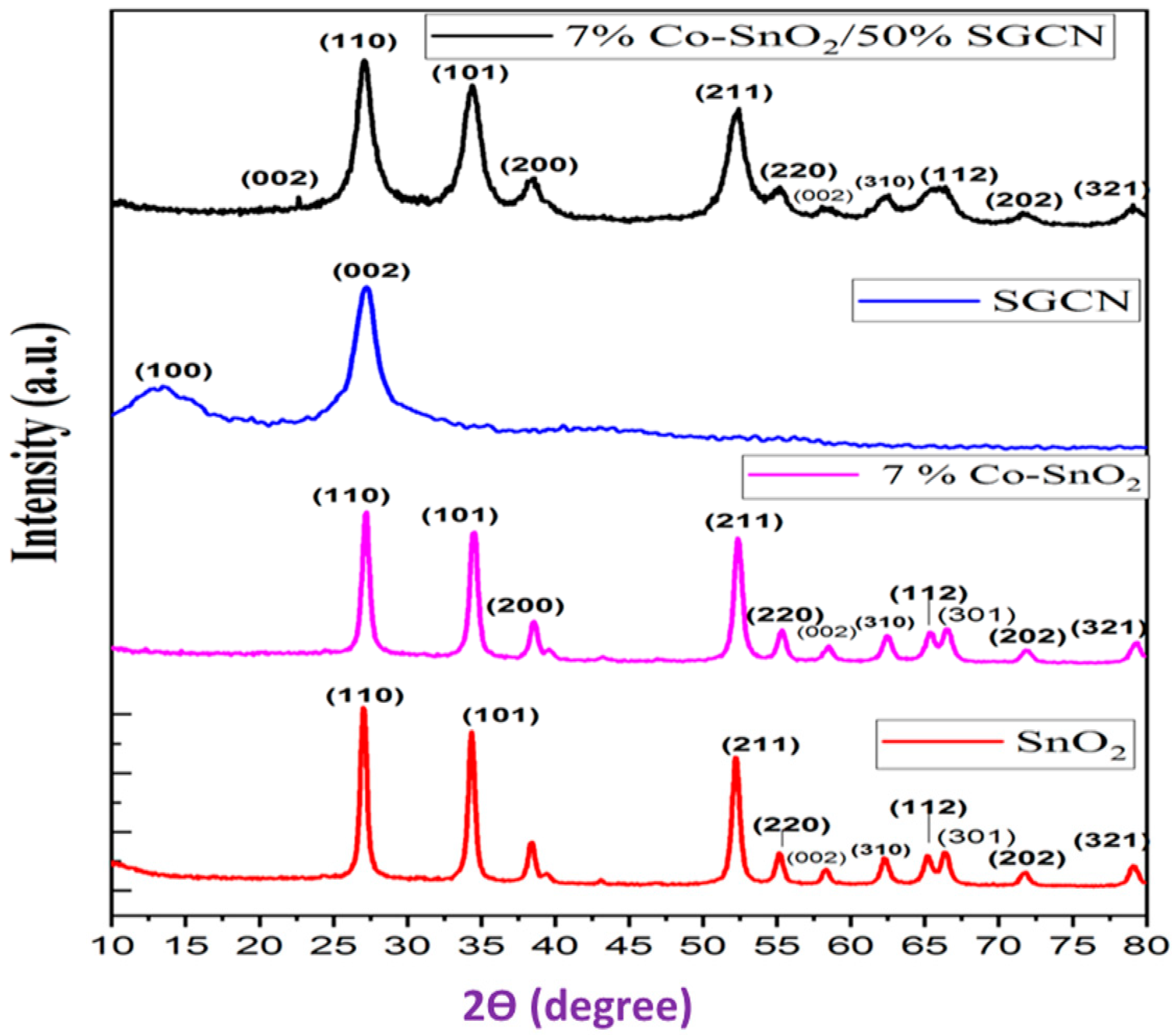
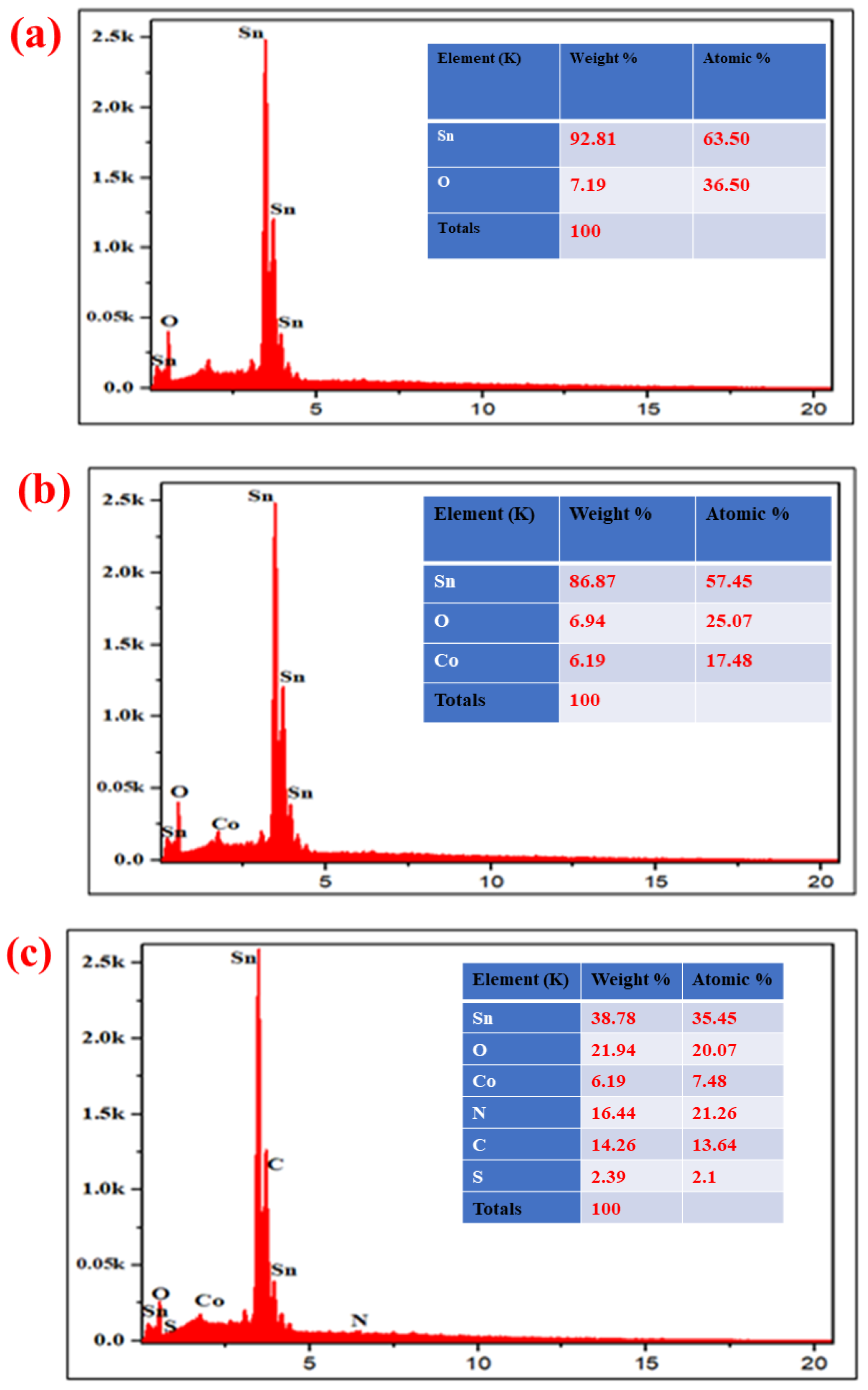
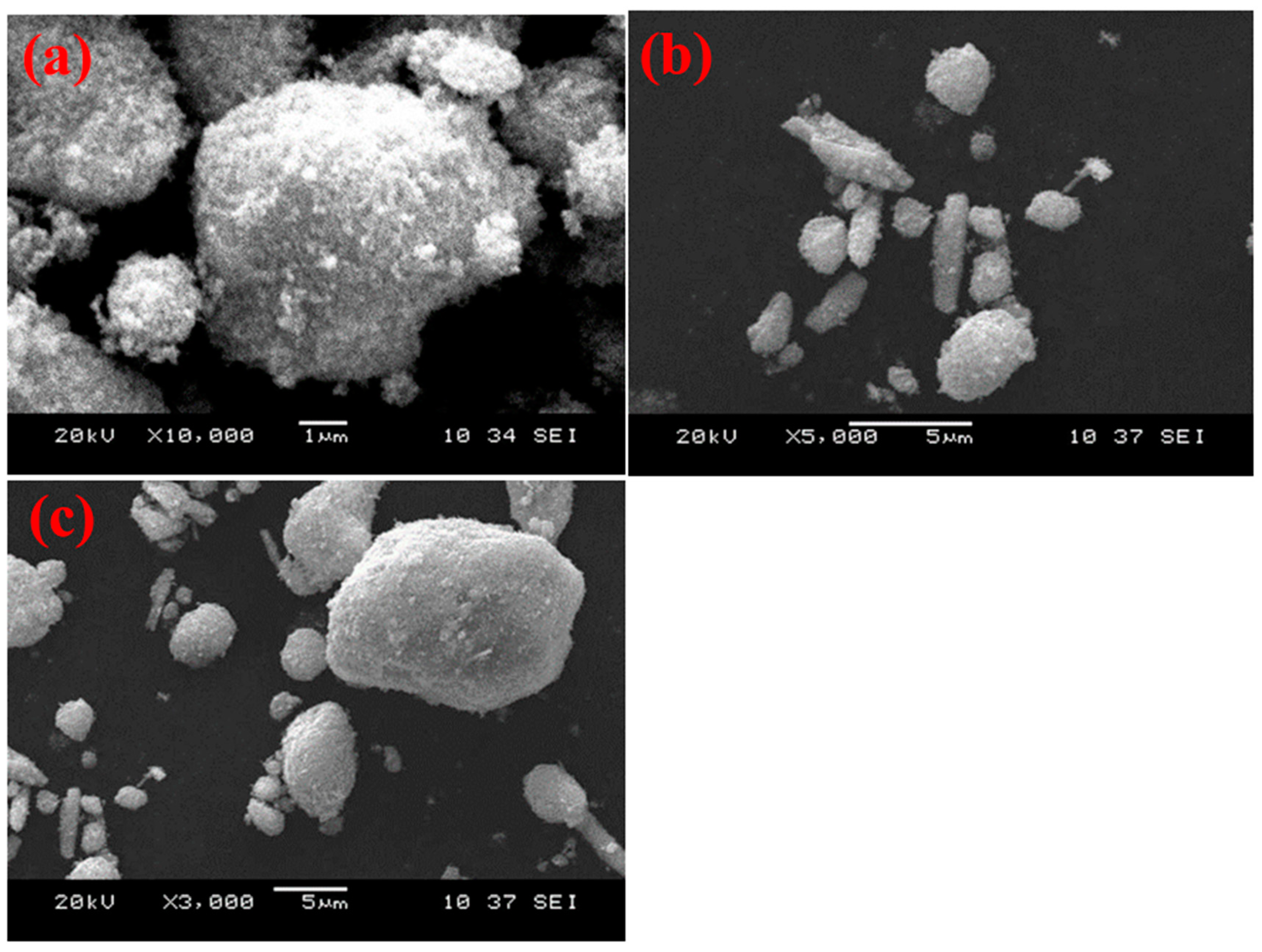
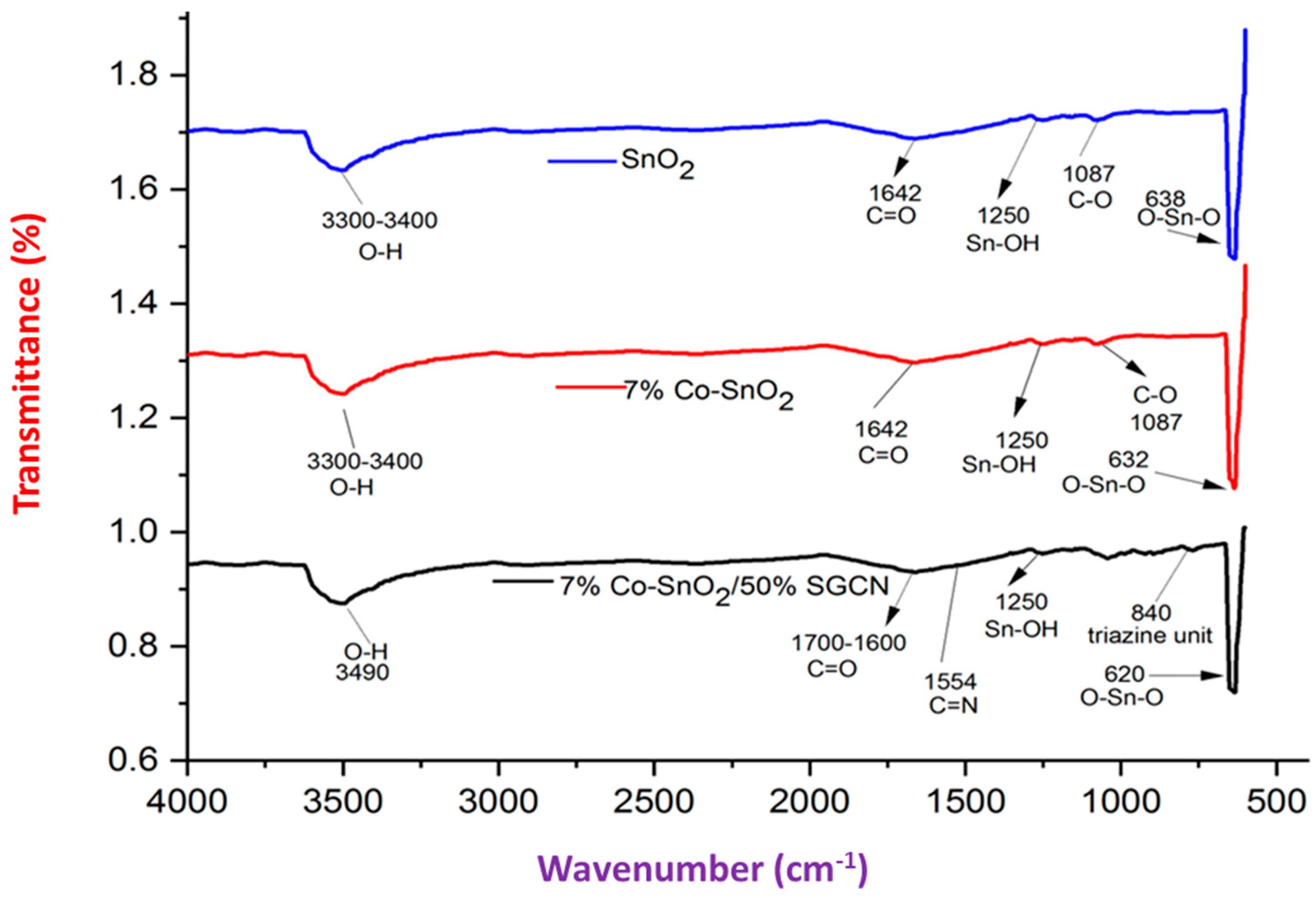
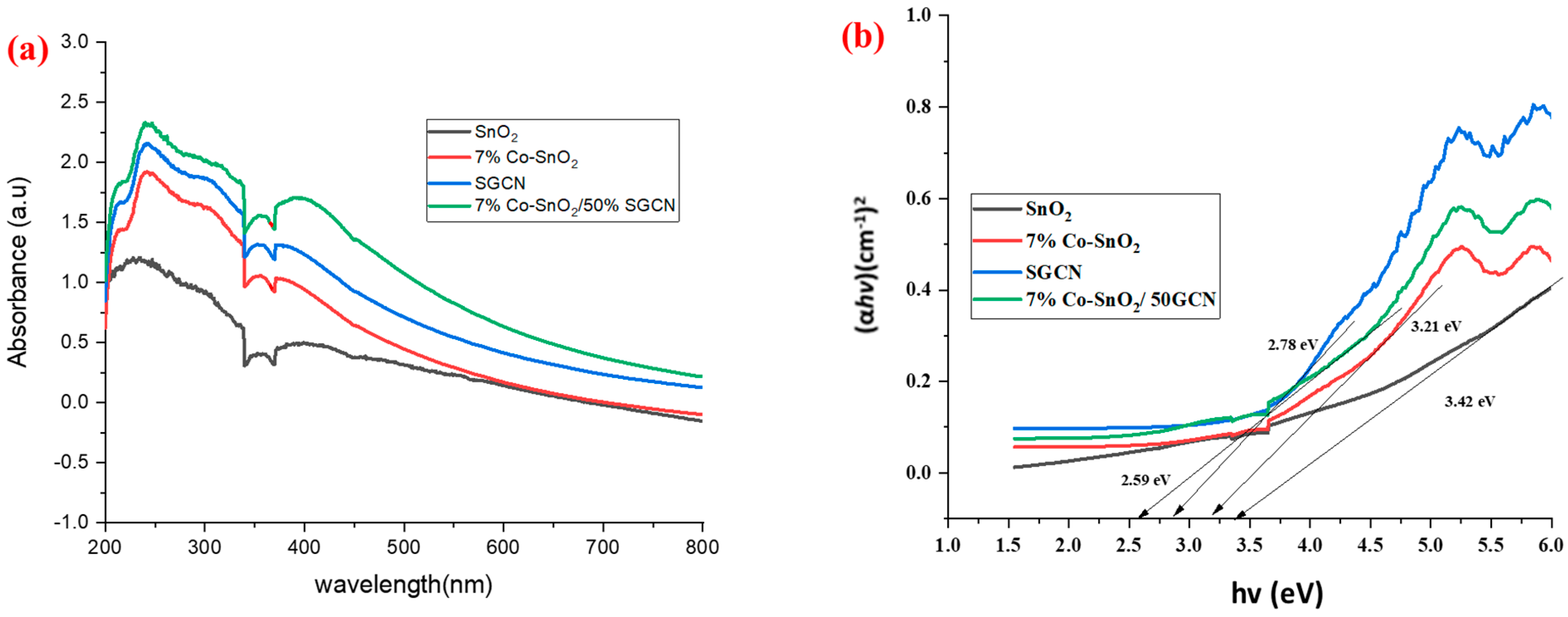
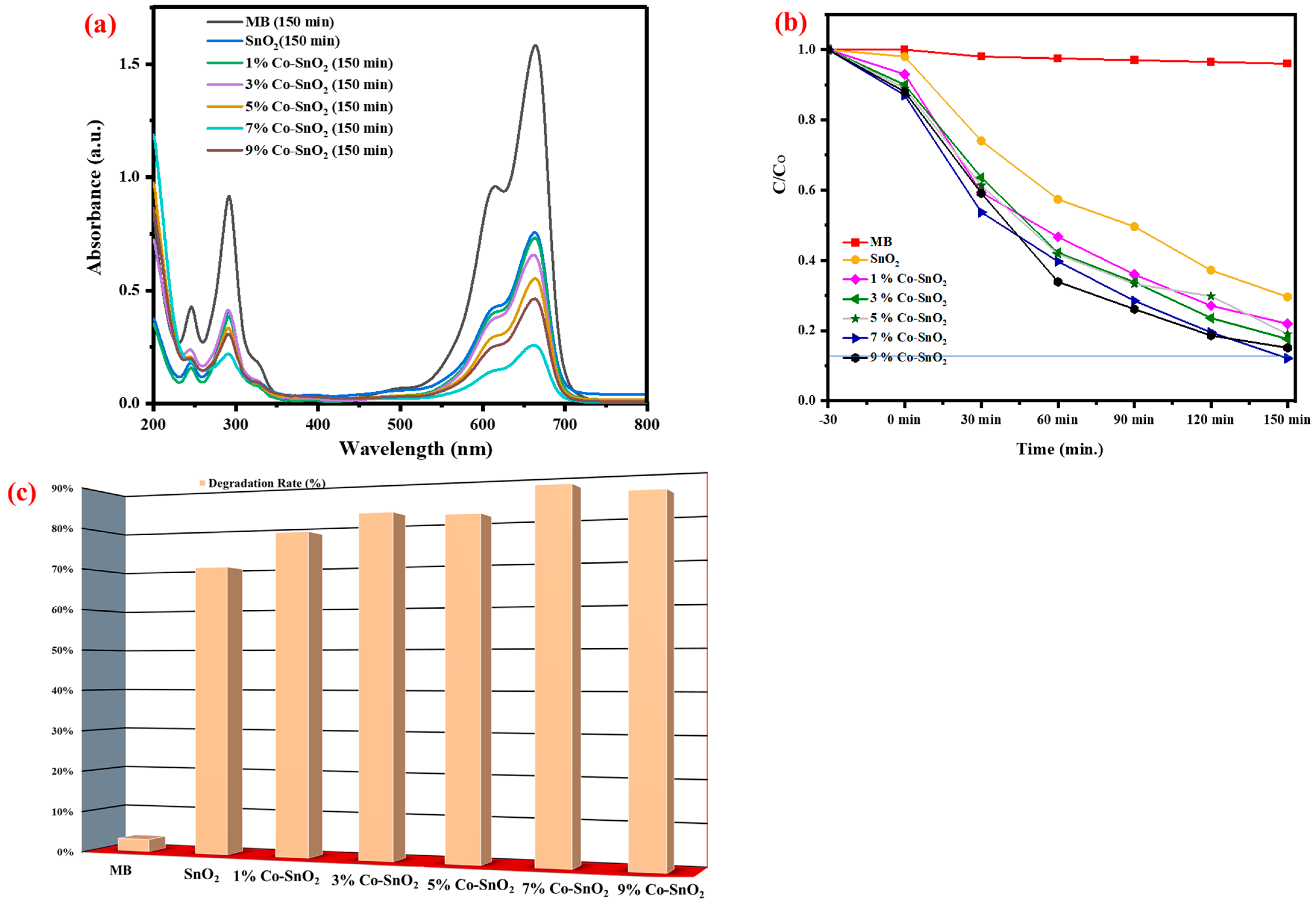
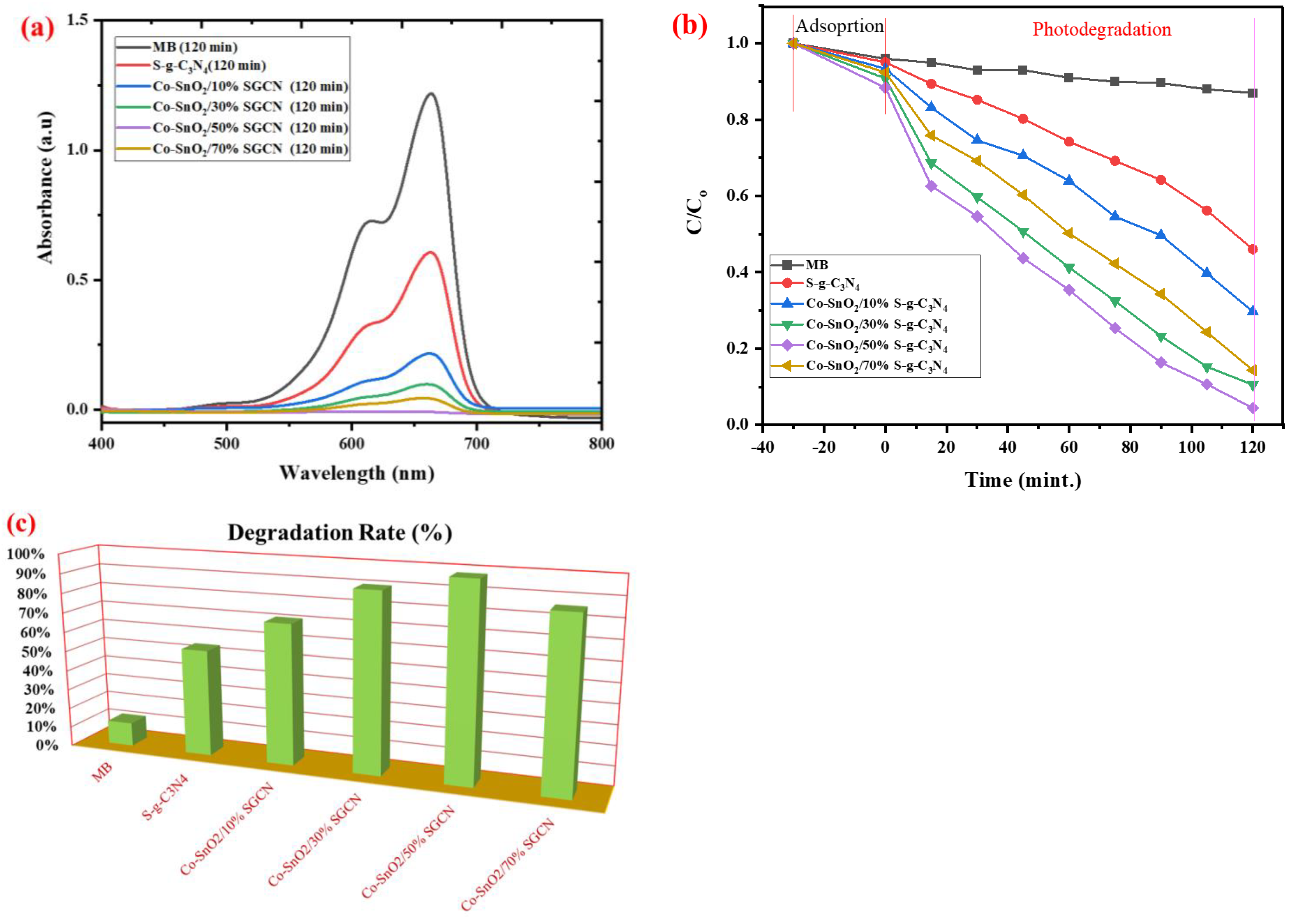
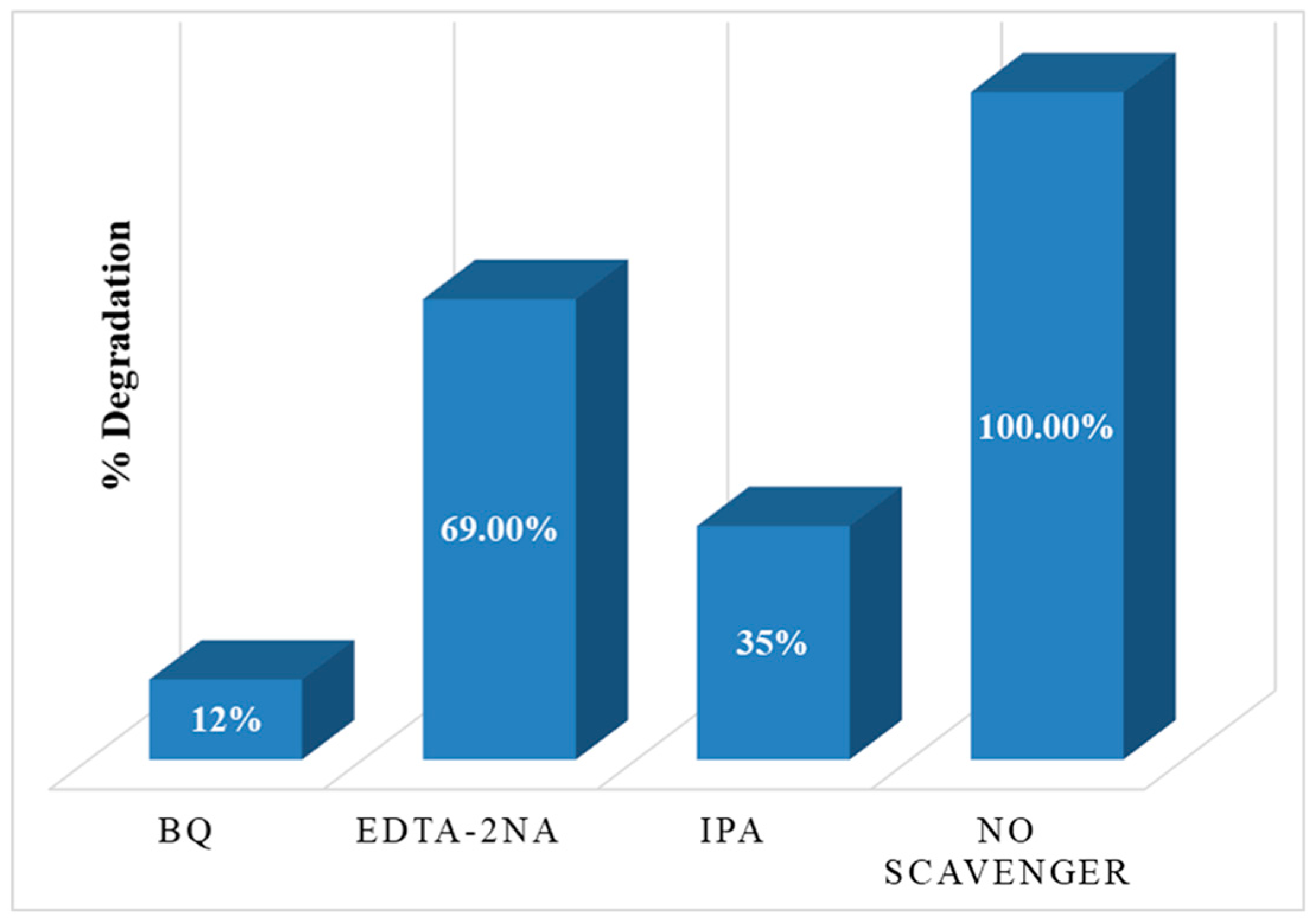
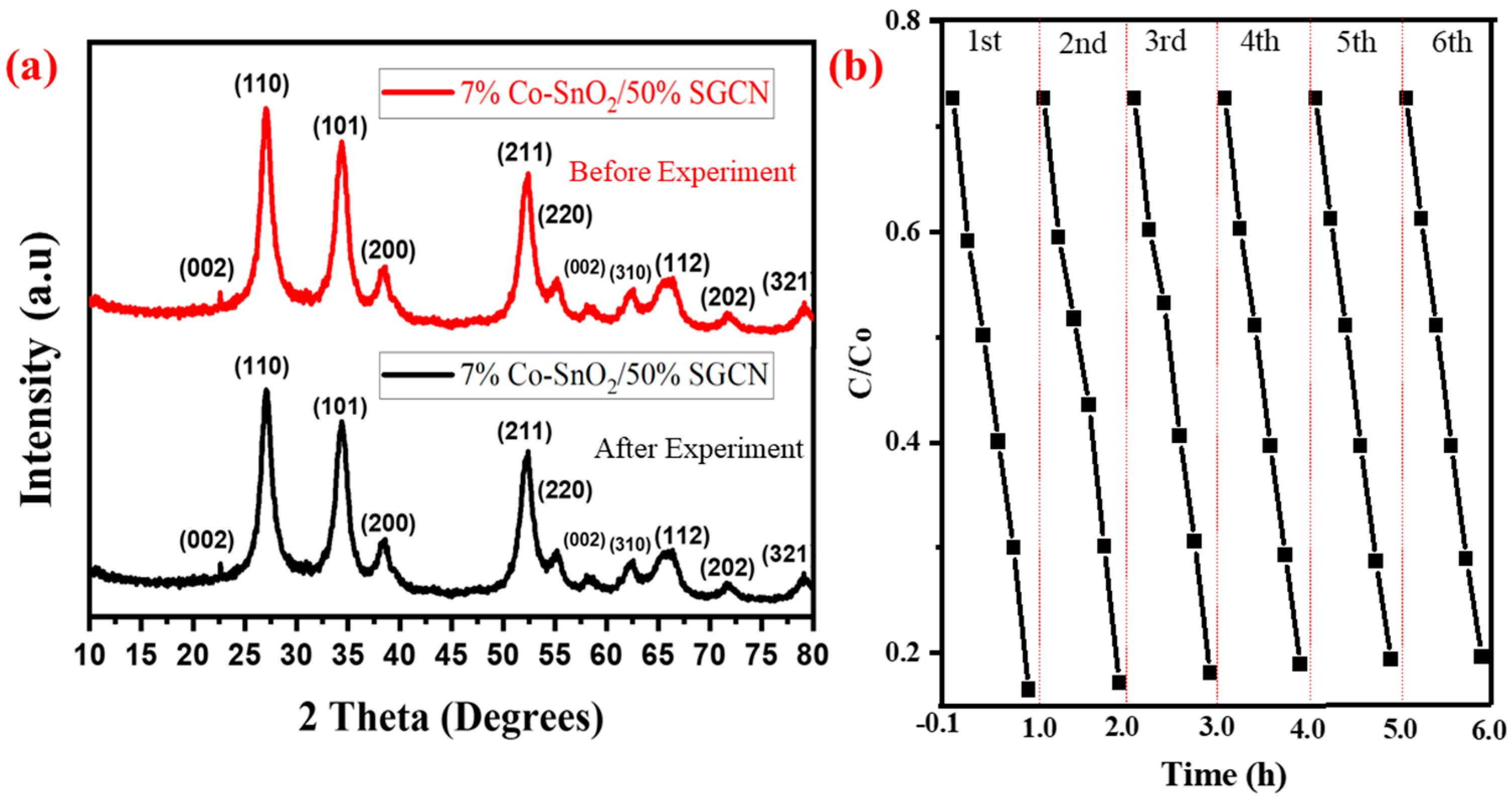
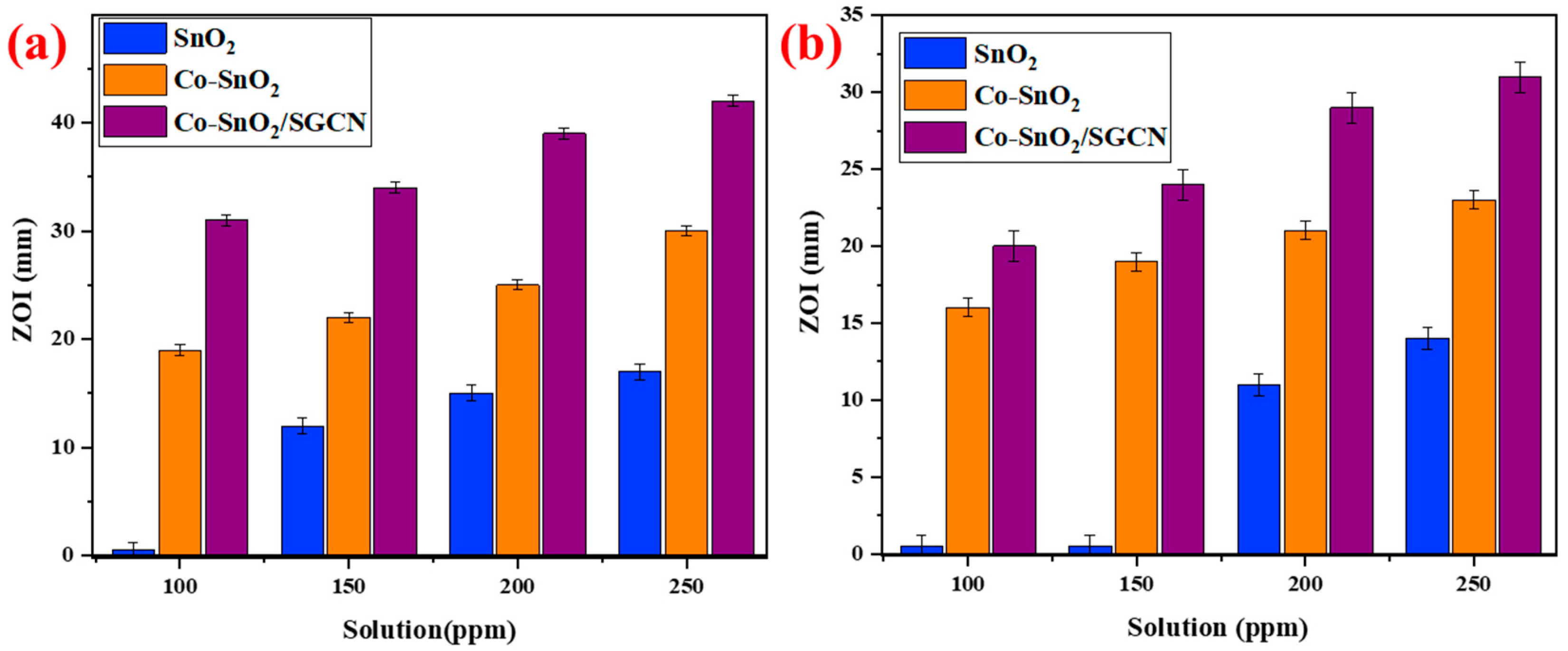

| Percentage | SnCl2.2H2O (g) | Co(NO3)2.6H2O (g) |
|---|---|---|
| 1% | 4.129 | 0.063 |
| 3% | 4.817 | 0.187 |
| 5% | 4.712 | 0.315 |
| 7% | 4.607 | 0.447 |
| 9% | 4.515 | 0.576 |
| Sr. No | % Age of SGCN in NCs | SnCl2.2H2O (g) | Co(NO3)2.6H2O (g) | Sulfur Doped Graphitic Carbon Nitride |
|---|---|---|---|---|
| 1 | 10% | 4.607 | 0.447 | 0.275 g |
| 2 | 30% | 4.607 | 0.447 | 0.827 g |
| 3 | 50% | 4.607 | 0.447 | 1.379 g |
| 4 | 70% | 4.607 | 0.447 | 1.931 g |
| Sr. No | Photocatalyst | Contaminant | Light Source | Radiation Time (min.) | Degradation % | Ref. |
|---|---|---|---|---|---|---|
| 1 | SnO2 | MB | Solar | 180 | 100 | [65] |
| 2 | SnO2-TiO2 | RhB | Visible | 120 | 90 | [66] |
| 3 | Co-SnO2 | RhB | Visible | 250 | 60 | [32] |
| 4 | ZnO-SnO2 | MB | Xe lamp | 180 | 95 | [67] |
| 5 | Zn2SnO4-SnO2 | MB | UV-Visible | 360 | 99.4 | [68] |
| 6 | Fe2O3/SnO2 | MB | UV | 90 | 70 | [69] |
| 7 | TiO2/Ag/SnO2 | MB | Visible | 140 | 90 | [70] |
| 8 | Co-SnO2/SGCN | MB | Solar | 120 | 98 | Present Work |
| Diameter of ZOI (mm) for Different Concentrations (ppm) | ||||||||
|---|---|---|---|---|---|---|---|---|
| Samples | E. coli | B. subtilis | ||||||
| 100 | 150 | 200 | 250 | 100 | 150 | 200 | 250 | |
| Tin oxide | - | 12 | 15 | 17 | - | - | 11 | 14 |
| 7% Co-SnO2 | 19 | 22 | 25 | 30 | 16 | 19 | 21 | 23 |
| 7% Co-SnO2/SGCN | 31 | 34 | 39 | 42 | 20 | 24 | 29 | 31 |
Disclaimer/Publisher’s Note: The statements, opinions and data contained in all publications are solely those of the individual author(s) and contributor(s) and not of MDPI and/or the editor(s). MDPI and/or the editor(s) disclaim responsibility for any injury to people or property resulting from any ideas, methods, instructions or products referred to in the content. |
© 2023 by the authors. Licensee MDPI, Basel, Switzerland. This article is an open access article distributed under the terms and conditions of the Creative Commons Attribution (CC BY) license (https://creativecommons.org/licenses/by/4.0/).
Share and Cite
Javed, M.; Iqbal, S.; Qamar, M.A.; Shariq, M.; Ahmed, I.A.; BaQais, A.; Alzahrani, H.; Ali, S.K.; Masmali, N.A.; Althagafi, T.M.; et al. Fabrication of Effective Co-SnO2/SGCN Photocatalysts for the Removal of Organic Pollutants and Pathogen Inactivation. Crystals 2023, 13, 163. https://doi.org/10.3390/cryst13020163
Javed M, Iqbal S, Qamar MA, Shariq M, Ahmed IA, BaQais A, Alzahrani H, Ali SK, Masmali NA, Althagafi TM, et al. Fabrication of Effective Co-SnO2/SGCN Photocatalysts for the Removal of Organic Pollutants and Pathogen Inactivation. Crystals. 2023; 13(2):163. https://doi.org/10.3390/cryst13020163
Chicago/Turabian StyleJaved, Mohsin, Sana Iqbal, Muhammad Azam Qamar, Mohammad Shariq, Inas A. Ahmed, Amal BaQais, Hanan Alzahrani, Syed Kashif Ali, N. A. Masmali, Talal M. Althagafi, and et al. 2023. "Fabrication of Effective Co-SnO2/SGCN Photocatalysts for the Removal of Organic Pollutants and Pathogen Inactivation" Crystals 13, no. 2: 163. https://doi.org/10.3390/cryst13020163
APA StyleJaved, M., Iqbal, S., Qamar, M. A., Shariq, M., Ahmed, I. A., BaQais, A., Alzahrani, H., Ali, S. K., Masmali, N. A., Althagafi, T. M., & Shakir Khan, M. (2023). Fabrication of Effective Co-SnO2/SGCN Photocatalysts for the Removal of Organic Pollutants and Pathogen Inactivation. Crystals, 13(2), 163. https://doi.org/10.3390/cryst13020163






